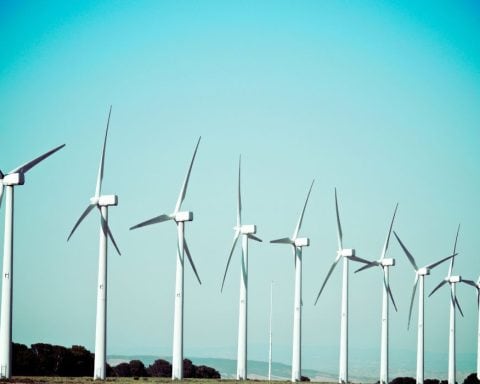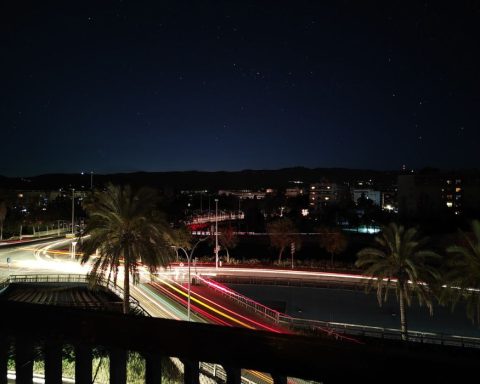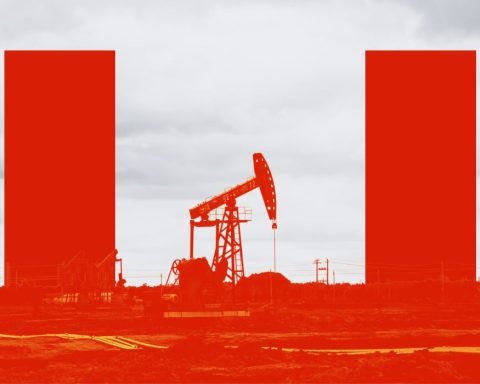Weeks after Ontario’s Independent Electricity System Operator (IESO) triumphantly unveiled the biggest battery storage procurement in Canadian history, persistent questions remain about how much of that storage capacity will be powered by high-emitting natural gas, The Energy Mix has learned.
As the IESO moves ahead with plans to add 1,500 megawatts of new natural gas-fired generating capacity at four existing generating stations, independent analysts are also looking into how long the province will actually be using the gas plants, how much they’ll drive up climate pollution – and whether the procurement was needed in the first place.
The discussion about provincial power planning became that much more complex and fraught over the last week, when Energy Minister Todd Smith announced a procurement for utility-scale renewables in 2025-26 that he said would be the biggest the country has ever seen. The province is moving immediately to add 4,800 MW of new nuclear capacity at the massive Bruce complex on Lake Huron and three more small modular nuclear reactors at the Darlington nuclear generating site on Lake Ontario.
But the other big uncertainty is the extent to which the IESO’s battery procurement will end up depending on natural gas, a fuel whose primary component is methane, a climate super-pollutant with 85 times the warming potential of carbon dioxide over a 20-year span.
‘Clean’ Battery Storage from a Fossil Fuel
In its May 16 media release on the gas plant procurement, the IESO put most of the emphasis on the seven new battery projects totalling 739 megawatts, yet another Canadian first for the biggest storage buy ever. The concurrent decision to push ahead with new gas capacity means a large share of the electricity flowing into those batteries may be generated from a high-emitting fossil fuel. But a review of the IESO’s in-house analysis over the last two years suggests the grid operator might not be entirely sure how much or how often that will happen:
• A data table [xlsx] accompanying the IESO’s December, 2022 Annual Planning Outlook shows the percentage of the time that gas is the “marginal resource” increasing from 24% in 2023 to 54% in 2024, 81% in 2027, 89% in 2033, and 99% in 2037, then holding at 99 or 100% through 2043.
• But the equivalent table [xlsx] from the December, 2021 outlook indicated much heavier reliance on emissions-heavy gas—70% in 2023, 74% in 2024, 91% in 2027, and 100% in 2043.
Both sets of numbers bear out the note in the 2022 outlook that “the escalating trend continues quickly prior to 2028 as demand grows and other [power generating stations] come out of service, as natural gas facilities will increasingly be the marginal resource.” But the higher numbers mean more gas being burned sooner, more emissions going into the atmosphere as a result, and the IESO’s numbers shifting in the course of a single year to indicate a smaller climate impact.
An IESO spokesperson did not respond to questions about how much of the electricity destined for battery storage will be generated from gas, or how the IESO calculated that percentage prior to this week’s announcements. The IESO and the Ministry of Energy both said it’s too soon to say how the new renewable energy procurement will shift that picture. “As the 2025-26 procurement is still being designed, target quantities and commercial operation dates are yet to be determined through consultation with the IESO and other stakeholders,” said Ministry spokesperson Michael Dodsworth.
“The IESO says the new gas they need and the existing gas they have in the short and medium term will continue to be for peaking, and will cover temporary periods when the combination of regular outages and nuclear refurbishments results in a shortfall,” he said. “But it’s very temporary. It’s a transitional issue. The new place we’re going doesn’t have any gas generation. It may be 10 years before we get there, but we don’t need it.”
300% Higher Emissions by 2030
The IESO’s gas plant plan remains controversial, however. The mid-May announcement included a decision to procure 586 megawatts of new natural gas-fired power production by expanding capacity at the Portlands Energy Centre in Toronto and three other existing gas plants in Halton Hills, Brampton, and Thorold. At the time, the Ontario Clean Air Alliance (OCAA) estimated that action would boost gas from 4% of the province’s electricity production in 2017 to 27% in 2043, flying in the face of Ottawa’s plan for a net-zero grid by 2035.
In mid-June, Toronto city council passing another resolution urging the federal government to frame its upcoming Clean Electricity Regulations to prohibit the 50 MW of new gas-fired capacity at Portlands.
“The Government of Ontario is planning to increase the greenhouse gas pollution of our gas-fired power plants by more than 300% by 2030 and by 700% by 2043, relative to 2017 levels,” OCAA Chair Jack Gibbons wrote [pdf] in a letter to council. “We have cleaner and lower-cost options to keep our lights on during our hottest summer days and coldest winter nights.”
In May, as well, the province announced C$342 million in new demand response incentives for households, in the form of $75 prepaid credit cards for smart thermostat owners, along with new energy-saving options for businesses, municipalities, and other institutions. The programs are part of a $1-billion conservation and demand management framework that is meant to reduce peak power demand by 725 MW, SustainableBiz wrote at the time.
Those savings aren’t nearly enough to offset the new power demand Ontario will see as end uses like home heating and personal vehicles electrify and the province takes its aging nuclear power plants offline for refurbishment. But outside observers have little confidence that the IESO has fully factored in the potential for more aggressive energy efficiency measures or renewable electricity generated from, smaller-scale, distributed energy resources (DER)—or that the independent agency’s political masters at Queen’s Park would want it to.
Renewables: How Much, How Soon?
In an extended email correspondence, the IESO spokesperson insisted the organization’s projections for distributed resources fully reflected their potential to address a looming electricity shortfall that the province has seen coming since 2018. “To help meet electricity needs in 2025-2027 and beyond,” he told The Energy Mix, “there is currently no like-for-like resource that can replace the operational flexibility natural gas generation provides, which is critical for maintaining the reliability of the grid.”
Further DER capacity, he added, “largely won’t materialize until the 2030s.”
But the gas plant procurement proceeded under an October, 2022 order in council from Smith that allows for the plants to operate through 2040, five years after the upcoming federal regulations are expected to mandate a 100% net-zero grid. The provincial directive provides for projects that can’t meet the new regulatory standard to “suspend operations for the balance of the contract term while retaining payments” from Ontario ratepayers or taxpayers, compensating them through a system of availability payments that will keep them on standby in case they’re needed.
But as The Energy Mix reported in May, the IESO announced the procurement months after it released a study by Montreal-based Dunsky Energy + Climate Advisors that showed how DERs could clear the electricity shortfall. While the “achievable potential” to meet peak summer demand was just 1.3 to 4.3 gigawatts through 2032, the economic potential—what the province could cost-effectively achieve – invariably exceeded the demand peak in winter and far exceeded it in summer.
A subsequent analysis for The Atmospheric Fund by the Concord, MA- and Toronto-based Power Advisory consultancy found that Ontario could cut projected climate emissions 85% by 2035 and reduce its use of carbon-heavy, gas-fired power plants to less than 3% of power production if the grid met rising electricity demand with energy efficiency, solar, wind, and energy storage. It showed the province’s ratepayers saving up to $9.5 billion on wholesale electricity costs compared to a plan where new wind and solar installations were replaced with gas. That was after factoring in the cost of efficiency measures that would save 23 terawatt-hours of electricity per year.
Winfield said the disconnect between those two analyses and the IESO’s procurement plan reflects fundamentally different approaches to power system planning.
“My reading of the Power Advisory report was that what they were talking about was technically feasible and economic in practice,” he said. “The question was really around the regulatory market model, what are the rules going to be that would enable this to occur.” Those in-the-weeds discussions between the IESO and the Ontario Energy Board were under way in late May, he added, “which then would [undercut] the notion that we’re stuck until 2030 or beyond. In a sense, it contradicts the finding of their own report, to put it bluntly.”
‘Obtainable Resources’ Mean Less Need for Gas
The Power Advisory analysis found that “there are obtainable resources here now, which would obviate the need for capacity expansions, particularly the gas expansions which seem to be under way,” Winfield said. That makes the IESO’s decision to postpone significant reliance on DERs “an inversion of what would make sense in this situation: you would pursue your achievable, tangible, scaleable, incremental resources first, and think longer and harder about the stuff that has very high risk, high capital costs, very high [emission] lock-in effects after you’re through optimizing the other resources.”
DERs “are also the ones that are fastest to deploy,” he added. And when it comes to maximizing energy efficiency, “we know how to do this in Ontario. We had a relatively comprehensive strategy on the demand side. So it’s not like we’re starting from zero.”
But even so, Winfield said it appears the IESO is “locking in the big, centralized stuff first, then leaving the more scaleable options to the margins and apparently further down the road, which really doesn’t make any sense from a planning perspective.”
Shepherd pointed to another powerful advantage in maximizing the use of distributed resources: a more robust system that is more resilient in an era of climate disruption.
“If we had generation and load in the same place, much less transmission would be needed,” he said. “That’s been the whole point of distributed energy resources for years. We talk about it now as if it’s a renewable energy concept, but it didn’t start out that way—it started with the emphasis on ‘distributed’.”
The problem is that DERs need a more robust distribution grid. “Today, the old-style distribution system is [based on] a hub-and-spoke approach,” he explained. “You have a transmission system or a municipal substation and lines go out in different directions.” In a modern system that maximizes DERs, “electricity distribution goes out in a loop, so you never lose the ability to serve an area. It also means you can put more generation on those lines and still keep the system in balance.”
That change in concept puts Ontario at a moment of opportunity, if only the provincial government would seize it. “Now we have a bunch of old distribution systems that are a little bit clunky, and they need to be upgraded anyway, because they’re old,” Shepherd said. “We also need control systems that are sufficient to manage a grid where load and generation are happening on an unpredictable basis.” That could mean a new revenue stream for local distribution companies, but also an opportunity to choose the future grid infrastructure that will reduce the province for higher-emitting, less resilient generation options like gas.
In his email response, the IESO spokesperson maintained that “there is currently nothing that can replace the reliability and flexibility that gas generation provides. We will continue to need it as we transition through this period of nuclear refurbishments and as emerging technologies mature.”
This article is republished from The Energy Mix. Read the original article.
Disclosure: The Energy Mix Publisher Mitchell Beer was previously a contract writer for the IESO.





